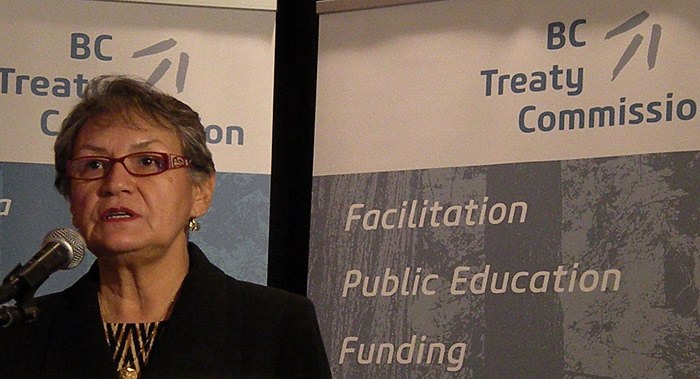VICTORIA – Three years ago, long-time chief and band administrator Sophie Pierre sought an extension of her term leading the B.C. Treaty Commission and gave a warning. The federal and provincial government should start taking this long and costly effort seriously or “shut ’er down.”

Last week Pierre wound up her sixth and final year as chief commissioner on a slightly more hopeful note. This year, the Tla’amin Nation in the Powell River area and the Yale First Nation in the Fraser Canyon had their treaties proclaimed by Ottawa.
They join the Maa-nulth First Nations on Vancouver Island and the Tsawwassen First Nation in leaving behind the Indian Act and the courts to get on with self-government. Tsawwassen in particular has moved ahead aggressively. Its shopping centre and housing development near the ferry terminal is one of the largest commercial projects in the province right now.
All of these treaties were negotiated despite multiple overlapping territorial claims around them, and similar progress has been made with the Tsimshian First Nations on the North Coast and elsewhere.
The need for aboriginal people to work out their overlapping claim issues between themselves was the focus of the commission’s 22nd annual report. Former chief commissioners Miles Richardson of the Haida Nation and Steven Point of the Sto:lo Nation added their influential voices, urging aboriginal communities to consider them shared territories, rather than clinging to ancient tribal rivalries.
Another hopeful sign is that after seven years of commissions and studies, the federal government has finally given its negotiators a mandate to negotiate fisheries. This is the main reason why the Tla’amin waited five long years for Ottawa’s blessing after their treaty had been hammered out.
This year’s landmark decision of the Supreme Court of Canada, recognizing Tsilhqot’in Nation title in the remote Nemiah Valley, has also got the attention of Victoria and Ottawa. Pierre noted the “flurry of activity” by Premier Christy Clark in seeking reconciliation, which will culminate this month with a formal apology for the hanging of Tsilhqot’in chiefs 150 years ago.
Pierre said this court ruling “should destroy any lingering thoughts that this issue is not of the utmost importance, and provide the necessary investment, both financial and time commitment, to reach satisfactory conclusions.”
That’s the good news for B.C.’s thorniest historical problem, the lack of treaties across most of the province.
It’s also becoming clearer that the Tsilhqot’in ruling is unique. It’s unlikely to be repeated by most other First Nations, even if they are willing and able to spend the years and millions to enrich lawyers in pursuit of it.
Here’s the bad news. As of this year, the B.C. Treaty Commission has paid out $627 million to First Nations to support treaty negotiations. Most of that is in the form of loans, which are to be repaid out of the cash settlements that Ottawa contributes to settle modern treaties.
Pierre acknowledges that some communities are close to completing treaties, but their debt has climbed to near what Ottawa is offering. This would leave them free but broke.
Others are just “spinning their wheels” with no real hope of achieving a treaty, Pierre said. The commission is calling for an “exit strategy” for these communities, starting with loan forgiveness that would allow them to pursue economic activity.
There are First Nations, Westbank and Osoyoos prominent among them, which are thriving without treaties. Haida and Klahoose have developed successful forest products businesses as they move toward self-government.
Federal and provincial governments must recognize the successes, and the failures.
Tom Fletcher is legislature reporter and columnist for Black Press. Twitter: @tomfletcherbc
